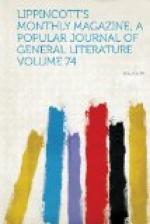It was when this career had borne its inevitable fruit, and he was but a mere wreck of the polished gentleman of a few years previous, that Brullof came to the Via San Basilio, where, as soon as the fact became known, visitors began to call. Among the first were the Russian ambassador and suite, who were driven up in a splendid carriage, with liveried attendants; but after the burly Italian had announced to his master who was in waiting, the door was closed, and with no message in return the representatives of the mightiest empire on the globe were left to withdraw with the best grace they could muster for the occasion. Similar scenes were repeated often during the entire Roman season. He saw but few of his callers—Russians, never.
The Russian and the American artists became quite intimate during the few months they were thrown together, and Mr. Brown has acknowledged that he owes much of the success of his later efforts to hints received from the self-exiled, dying Russian.
“Mr. Brown,” he said on one occasion, while examining the picture on the artist’s easel, “no one since Claude has painted atmosphere as you do. But you must follow Calame’s example, and make drawing more of a study. Draw from Nature, and do it faithfully, and with your atmosphere I will back you against the world. That is bad,” pointing to the huge limb of a tree in the foreground: “it bulges both ways, you see. Now, Nature is never so. Look at my arm,” speaking with increased animation, and suddenly throwing off his coat and rolling up his shirt-sleeve. “When you see a convexity, you will see concavity opposite. Just so in Nature, especially in the trunks and limbs of trees.”
This criticism made such an impression on Brown that it decided him to go into more laborious work, and was the foundation of his habit of getting up at daybreak and going out to sketch rocks, trees and cattle, until he stands where he now does as a draughtsman.
The painting which Brullof had first admired, and which had induced him to compare Brown to Claude in atmospheric effects, was a view of the Pontine Marshes, painted for Crawford the sculptor, and now in possession, of his widow, Mrs. Terry, at Rome.
During this entire season the penuriousness exhibited by Brullof is one of the hardest phases of his character to explain. Though he was worth at least half a million of dollars, his meals were generally of the scantiest kind, purchased by the Italian cicerone, and cooked and eaten in his room. Yet a kindness would touch the hidden springs of his generosity as the staff of Moses did the rock of Horeb.




